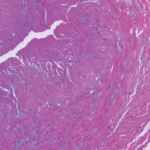In the case of prostate cancer, for example, the patient progression is relatively simple, moving from prostate hypertrophy through prostate cancer to cancer-associated anemia. The COPD cluster also had a characteristic pattern, which included a variety of diagnoses, including cardiovascular, skin, endocrine and behavioral disorders. Most patients diagnosed with COPD went on to have increased cardiovascular diagnoses, including angina pectoris and atherosclerosis. The investigators also found that cerebrovascular and diabetes clusters tended to converge to epilepsy and retinal disease, respectively.
The authors concluded that trajectory analyses may have a useful role in personalized medicine to help predict and prevent disease in individual patients. For example, they point out that a patient with a diagnosis of angina and ischemic heart disease who is then diagnosed with gout is at a two-fold increased risk for cardiac arrest compared with a similar patient who is not diagnosed with gout. (posted 7/31/14)
Lara C. Pullen, PhD, is a medical writer based in the Chicago area.
Reference
1. Jensen AB, Moseley PL, Oprea TI, et al. Temporal disease trajectories condensed from population-wide registry data covering 6.2 million patients. 2014. Nat Commun. Jun 24; doi:10.1038/ncomms5022. [Epub before print].



